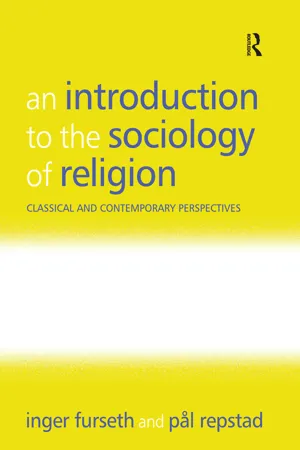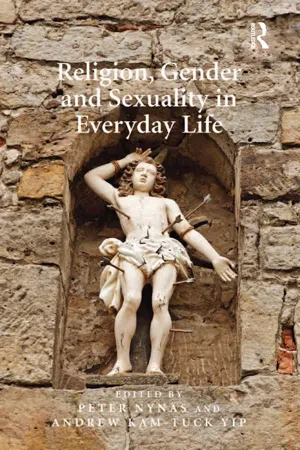Social Sciences
Gender and Religion
Gender and religion intersect in complex ways, shaping beliefs, practices, and power dynamics within religious communities. This intersection influences concepts of masculinity, femininity, and non-binary identities, as well as the roles and expectations placed on individuals within religious contexts. The study of gender and religion explores how these dynamics impact social structures, rituals, and interpretations of religious texts.
Written by Perlego with AI-assistance
Related key terms
3 Key excerpts on "Gender and Religion"
- eBook - ePub
An Introduction to the Sociology of Religion
Classical and Contemporary Perspectives
- Inger Furseth, Pål Repstad(Authors)
- 2017(Publication Date)
- Routledge(Publisher)
Over the last decades a large number of studies have been conducted within the field of Gender and Religion. This chapter is meant to make only a small contribution. We will first consider different images of women and men found in the sacred texts within different world religions. A considerable number of books and articles have appeared on this topic, especially within theology and religious studies (see Sharma 1994; Young 1999). Yet the topic of women and religion is not confined to sacred texts and symbols only, but also to actual lives. What distinguishes the religious experiences of women from those of men? Several scholars have focused on religious institutions and attempted to determine the actual roles women have within different world religions or within various religious communities. Many studies of contemporary religiosity have described women’s responsiveness to religion. Social scientists who have analysed the high participation of women in religion have attempted to explain why this is so. Women’s religious participation has also been criticized. Feminism has claimed that religious women have “false consciousness.” Therefore, we will assess the relationship between feminism and religion. In discussions on Gender and Religion, a closely related topic is the religious interpretation of sexuality. Religion tends to regulate sexuality, and its directions and proscriptions are often directed towards women and towards homosexuals, lesbians, bisexuals, and transgender people. We will look at these issues towards the end of the chapter.Analyses of Gender and Religion often tend to lean towards generalizations. Women vary, as do men, according to social class, education, cultural heritage, ethnicity, race, and nationality. It is also important to remember that women and men, whether they are heterosexual, homosexual, lesbian, bisexual, or transgender, do not constitute single unified groups that have the same interests or are exposed to the same type of treatment or discrimination in every part of the world and at all times.11.1 The role of religion in interpreting gender and gender roles
As an introduction to the area of Gender and Religion we will give a brief overview of the images of women and men that are found in the world religions. What do the sacred texts teach about women? What are the symbols of femininity and masculinity? Traditionally, this field of research is conducted by scholars of theology and religious studies. However, living in increasingly multi-religious societies requires that social scientists also have a minimum of knowledge of some teachings of the world religions. Therefore, we will take a quick glance at the ideas regarding gender in Christianity, Judaism, Islam, Hinduism, Sikhism, and Buddhism.Within Christianity, theologians and philosophers have taught that God is neither male nor female. In the early 1980s the American Christian feminist Rosemary Radford Ruether presented one of the first systematic critiques of Christian theology from a feminist perspective in the book Sexism and God-talk - eBook - ePub
- Allyson Jule(Author)
- 2017(Publication Date)
- Multilingual Matters(Publisher)
In today’s global pluralism, almost any faith can be found anywhere, as a secure and steady presence for some and as a personal option or expression regarding religious persuasion for others. Hinduism, Buddhism and Islam (religions originating in the East) are found all over the West, and the various representations of the West’s Judaism and Christianity are now well established throughout the world. The massive rise in American-style politically right-wing evangelical Christianity has been a fascinating sociological phenomenon for some time – both in the United States and in other countries around the world – as has radical fundamentalist Islam. Religion and religious groups influence the geo-political world in regards to war zones, political campaigns and world governance. The rise of ISIS: the Islamic State, a terrorist organization emerging from within Islam, has massively influenced world events and shifts in geopolitical alliances. As such, the connections of gender and language with particular religious expressions make for fascinating case studies.Gender in the World ReligionsThe majority of the world’s population today regard themselves as religious in one way or another. The growing numbers might surprise those who are more familiar with the influential secular ideology of the West. A 2008 Gallup poll asked people in over 140 countries whether religion was an important part of their lives; 82% said yes (Mezit, 2011: 21).Because gender is socially constructed, it is fascinating to see how gender roles, expectations, and behaviors play out in religious communities. It is of ‘great significance for those who want to keep a status quo in a certain social system to insist on existing practices, values and orders. […] Often religious institutions undertake this task’ (Mezit, 2011: 4). Despite the intricate relatedness between religion and feminism (in particular, that early feminists relied on moral reasoning regarding the equality of all people as central to the Christian faith), many religious people discard feminism a priori because they associate it with a secular worldview. Likewise, many feminists discard religion as a matter of course because of the deep patriarchy at the core of religious dogma.Judith Plaskow (1990), in her feminist book Standing Again at Sinai - eBook - ePub
- Peter Nynäs, Andrew Kam-Tuck Yip(Authors)
- 2016(Publication Date)
- Routledge(Publisher)
Lassander (2012) argues that we have to abandon outdated categories and models, and approach religion as a hybrid, namely the reconfigurations of religion without reducing it to social or psychological components without each acknowledging the other. He refers to the model of ‘vernacular religion’ and how an individual’s religion is a process dependent on what she/he does with the religion, how she/he talks about it; what social actors are involved and how they are engaged. This kind of holistic process might prove fruitful, leading to a form of critical openness.This way to address religion may prove fruitful when exploring the intersection of contemporary religion from a perspective of the everyday, in particular when we acknowledge how this is embedded in a complexity of social, political and cultural processes, both local and transnational in nature, and how received categories such as ‘religious’ and ‘secular’, and ‘public’ and ‘private’, dissolve and manifest themselves in novel and decisive ways.The Contestation of Gender and Sexuality in Contemporary Society
Gender and sexuality are two key markers of an individual’s identity, particularly in our highly sexualised and mediatised culture. In social research, gender and sexuality have often been studied separately – with the former focusing primarily on women, and the latter, lesbians and gay men. In the everyday context, however, gender and sexuality are mutually implicated and inextricably linked. In other words, we live our gender and sexual identities in relation to each other; and others relate to us based on their perceptions of our gender in connection to our sexuality, and vice versa. For instance, masculinity is not only about norms, subjective feelings and bodily performances associated with being a man; it is also about desiring a woman as a sexual object – and vice versa. Thus, to be a man, it is not sufficient to just feel and act like a man, but such feeling and ‘acting out’ only makes sense if it includes desiring women (Dennis 2003 ). Masculinity, therefore, is traditionally constructed in a heteronormative fashion. Homo-intimacy and homo-eroticism are consequently discouraged, and indeed forbidden, precisely because they disrupt the gender and sexual script which dictates that a man must desire women in order to be a ‘proper’ man (e.g. McCormack and Anderson 2010 , Richardson 2010
Learn about this page
Index pages curate the most relevant extracts from our library of academic textbooks. They’ve been created using an in-house natural language model (NLM), each adding context and meaning to key research topics.


